Marcus Sedgwick's Blog, page 4
October 6, 2013
Read for RNIB
Less than 1% of books are published in Braille. No more than 7% of books are published in some format which makes them accessible to blind or visually impaired readers; formats such as audiobooks, Daisy readers, large or giant print, and even if a book appears in one of these formats; it may be months after the publication of the traditional format or e-book version.
Yes, it is possible for e-readers to 'speak' a digital copy of a book to the blind, but text-to-speech systems typically offer an unrealistic electronic voice. If you think you'd wouldn't mind having a full-length book read to you by something like that, you should try five minutes of it to see...
I am therefore extremely proud that my newly published book, She Is Not Invisible, is available in a wide range of accessible formats, and from day one of its life.
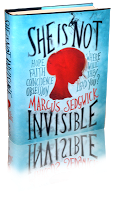 The book is about a 16-year-old girl whose father is a writer. He's a writer obsessed with the question of coincidences, and when he goes missing, Laureth decides to follow clues left behind in his notebook to try to find him. This is somewhat harder than it would be for most 16-year-olds, because Laureth has been blind from birth. That’s what made me convinced the book should be published in accessible formats from the start, and I’m delighted that my publisher, Orion, agreed.
The book is about a 16-year-old girl whose father is a writer. He's a writer obsessed with the question of coincidences, and when he goes missing, Laureth decides to follow clues left behind in his notebook to try to find him. This is somewhat harder than it would be for most 16-year-olds, because Laureth has been blind from birth. That’s what made me convinced the book should be published in accessible formats from the start, and I’m delighted that my publisher, Orion, agreed.
The book is part of RNIB’s Read for RNIB Day, and is one of six titles that have blind protagonists which have been chosen as suggested books for reading groups to read, in the Reading Group Challenge. This is a wonderful scheme aimed at raising money for the RNIB so they can continue their work of enabling the blind to have a better reading experience. The mere existence of certain charities in our society has always appalled me. The RNLI, the RNIB: aren't these services which any wealthy, civilised country ought to provide from central government? But they don't, so in the meantime, it's up to the rest of us to fund them, and help blind and VI people have an equal share in our country's culture.
It was, of course, an enormous challenge to write a book with a blind protagonist, not least because I chose to write from her point of view, in the first person. I had no idea just how great the challenge was until I started my research. Over the last two years I've made a series of trips to New College, Worcester, where I spoke at length with blind and VI students. Every single one of them was open, honest, generous and patient with me, and slowly, I began to get a little understanding of what life is like for them. How it is different, of course, but just as importantly, how it is the same. I cannot begin to pretend I know what it's like to be blind from birth, as Laureth is in the book. How could you ever forget what colour is, to give just one example? If I have achieved anything at all in this book, however, it's thanks to the help I received from the students there. I literally could not have written this book without them. It is their book, and I am grateful beyond words for the kindness they showed me.
Here's a short film made the RNIB about the day I went back to New College, with a finished copy of the book in my hands. And yes, I was really nervous.
Yes, it is possible for e-readers to 'speak' a digital copy of a book to the blind, but text-to-speech systems typically offer an unrealistic electronic voice. If you think you'd wouldn't mind having a full-length book read to you by something like that, you should try five minutes of it to see...
I am therefore extremely proud that my newly published book, She Is Not Invisible, is available in a wide range of accessible formats, and from day one of its life.
 The book is about a 16-year-old girl whose father is a writer. He's a writer obsessed with the question of coincidences, and when he goes missing, Laureth decides to follow clues left behind in his notebook to try to find him. This is somewhat harder than it would be for most 16-year-olds, because Laureth has been blind from birth. That’s what made me convinced the book should be published in accessible formats from the start, and I’m delighted that my publisher, Orion, agreed.
The book is about a 16-year-old girl whose father is a writer. He's a writer obsessed with the question of coincidences, and when he goes missing, Laureth decides to follow clues left behind in his notebook to try to find him. This is somewhat harder than it would be for most 16-year-olds, because Laureth has been blind from birth. That’s what made me convinced the book should be published in accessible formats from the start, and I’m delighted that my publisher, Orion, agreed.The book is part of RNIB’s Read for RNIB Day, and is one of six titles that have blind protagonists which have been chosen as suggested books for reading groups to read, in the Reading Group Challenge. This is a wonderful scheme aimed at raising money for the RNIB so they can continue their work of enabling the blind to have a better reading experience. The mere existence of certain charities in our society has always appalled me. The RNLI, the RNIB: aren't these services which any wealthy, civilised country ought to provide from central government? But they don't, so in the meantime, it's up to the rest of us to fund them, and help blind and VI people have an equal share in our country's culture.
It was, of course, an enormous challenge to write a book with a blind protagonist, not least because I chose to write from her point of view, in the first person. I had no idea just how great the challenge was until I started my research. Over the last two years I've made a series of trips to New College, Worcester, where I spoke at length with blind and VI students. Every single one of them was open, honest, generous and patient with me, and slowly, I began to get a little understanding of what life is like for them. How it is different, of course, but just as importantly, how it is the same. I cannot begin to pretend I know what it's like to be blind from birth, as Laureth is in the book. How could you ever forget what colour is, to give just one example? If I have achieved anything at all in this book, however, it's thanks to the help I received from the students there. I literally could not have written this book without them. It is their book, and I am grateful beyond words for the kindness they showed me.
Here's a short film made the RNIB about the day I went back to New College, with a finished copy of the book in my hands. And yes, I was really nervous.
Published on October 06, 2013 03:54
Patron of Reading: aka, I must have grown up somewhere along the way
I just made the first visit to a brand new school, Cambourne Village College, just outside Cambridge. I accepted their offer to become 'Patron of Reading' for this academic year, a title which makes me think I must have become a grown-up somewhere along my journey. Not that I noticed.
I was delighted to receive this invitation because Cambourne is a very rare thing - a brand new school. It's expanded out of Comberton Village College: Cambridge parents have obviously been busy and there is a bit of a population explosion going on.
So here's the front of the new building.
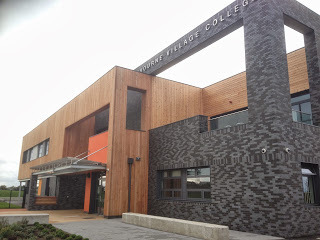 It's really beautiful, and inside are some great new teaching facilities, a sports hall, IT rooms etc etc and most importantly of all, a brand new library. It was Alison Tarrant, the librarian at the school, who had the idea to appoint a Patron of Reading, and she got in touch last summer to ask if I'd take on the role, the purpose of which is to champion reading through the school. Cambourne have a great plan - get this first year of students really into their reading and hopefully that will set the tone in future years. Their Head of School is former English teacher, and that helps a lot I think, but all the staff seem to be right behind this great initiative.
It's really beautiful, and inside are some great new teaching facilities, a sports hall, IT rooms etc etc and most importantly of all, a brand new library. It was Alison Tarrant, the librarian at the school, who had the idea to appoint a Patron of Reading, and she got in touch last summer to ask if I'd take on the role, the purpose of which is to champion reading through the school. Cambourne have a great plan - get this first year of students really into their reading and hopefully that will set the tone in future years. Their Head of School is former English teacher, and that helps a lot I think, but all the staff seem to be right behind this great initiative.
The idea is that I will have contact with this very first intake (150 year 7s) throughout their first year at the school. We'll meet, either for real or virtually in some way, once per half term from now till the summer before they head up to year 8. Todays, by way of introduction, I gave a talk to the whole year group in their shiny new hall, with possibly the largest projection screen I've ever seen :-0
The students were wonderful, had some great questions. I signed a load of books and really enjoyed our first session together, so thanks to Cambourne for the welcome.
And since this was reported today, it feels like my visit could not have come at a more appopriate time. Not that there was any evidence of children being embarrassed to be seen with a book here! The enthusiasm for reading was plain to see - the challenge is to keep children reading as the move up through the school system. I think Cambourne are well on the way to achieving that.
I was delighted to receive this invitation because Cambourne is a very rare thing - a brand new school. It's expanded out of Comberton Village College: Cambridge parents have obviously been busy and there is a bit of a population explosion going on.
So here's the front of the new building.
 It's really beautiful, and inside are some great new teaching facilities, a sports hall, IT rooms etc etc and most importantly of all, a brand new library. It was Alison Tarrant, the librarian at the school, who had the idea to appoint a Patron of Reading, and she got in touch last summer to ask if I'd take on the role, the purpose of which is to champion reading through the school. Cambourne have a great plan - get this first year of students really into their reading and hopefully that will set the tone in future years. Their Head of School is former English teacher, and that helps a lot I think, but all the staff seem to be right behind this great initiative.
It's really beautiful, and inside are some great new teaching facilities, a sports hall, IT rooms etc etc and most importantly of all, a brand new library. It was Alison Tarrant, the librarian at the school, who had the idea to appoint a Patron of Reading, and she got in touch last summer to ask if I'd take on the role, the purpose of which is to champion reading through the school. Cambourne have a great plan - get this first year of students really into their reading and hopefully that will set the tone in future years. Their Head of School is former English teacher, and that helps a lot I think, but all the staff seem to be right behind this great initiative.The idea is that I will have contact with this very first intake (150 year 7s) throughout their first year at the school. We'll meet, either for real or virtually in some way, once per half term from now till the summer before they head up to year 8. Todays, by way of introduction, I gave a talk to the whole year group in their shiny new hall, with possibly the largest projection screen I've ever seen :-0
The students were wonderful, had some great questions. I signed a load of books and really enjoyed our first session together, so thanks to Cambourne for the welcome.
And since this was reported today, it feels like my visit could not have come at a more appopriate time. Not that there was any evidence of children being embarrassed to be seen with a book here! The enthusiasm for reading was plain to see - the challenge is to keep children reading as the move up through the school system. I think Cambourne are well on the way to achieving that.
Published on October 06, 2013 03:51
October 2, 2013
Co-inky-dinks
Or, to give them their proper name, coincidences...
Co-inky-dinks is what they get re-christened by 7-year-old Benjamin, brother to Laureth, the heroine of my new book, She Is Not Invisible . Laureth and Benjamin's dad is a writer, a writer who's obssessed by two things: coincidences, and the number 354. He's been trying, and failing, to write a book about coincidence for years, and as the book opens, he's gone missing. Always a little away with the fairies, when his notebook turns up in New York when he was last heard of in Switzerland (or was it Austria), Laureth knows something is seriously wrong.
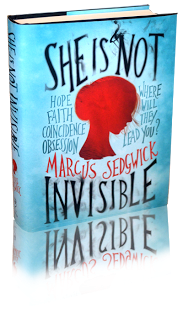 I also love coincidences, and coincidentally, have also been trying to write a novel about them for a very long while. I'm glad I've finished, now, so I can get obsessed about something else, but before I leave them alone for good, I just wanted to record a further coincidence that happened this week.
I also love coincidences, and coincidentally, have also been trying to write a novel about them for a very long while. I'm glad I've finished, now, so I can get obsessed about something else, but before I leave them alone for good, I just wanted to record a further coincidence that happened this week.
I've had some pretty weird ones happen to me over the years, and this is not the most spectacular, but it amused me a lot. Since in She Is Not Invisible, Laureth and Benjamin's dad is obsessed with the number 354, I thought I would work it into the text in as many ways as possible. It's there, sometimes deeply hidden in various ways, at other times very obvious.
Here are a few examples: each chapter title is composed of three words: three, then five, then four letters long. 'Two Dried Mice', for example. With one exception; the chapter which is simply called '354'. One chapter, 'The Final Clue', is comprised of a sequence of words that are 3,5,4 letters long in turn, and furthermore, there are exactly 354 words in that chapter. The page count of the book is 354 pages. The blurb conforms to a 354 structure. The word Dad is used 354 times in the book. The 354th word of the book is 'coincidence'. There are dozens more, but you get the idea.
So, the latest coincidence: Last week, a wonderful actress called Anna Cannings recorded the audiobook version. Last night, I got an email from the editor of the audio, saying he'd just finished the final cut of the reading, which, without him being aware of it as he was working, has ended up at 354 minutes long...
So, what coincidences do you have to share? I'd love to read about all and any in the comments, so feel free...
Co-inky-dinks is what they get re-christened by 7-year-old Benjamin, brother to Laureth, the heroine of my new book, She Is Not Invisible . Laureth and Benjamin's dad is a writer, a writer who's obssessed by two things: coincidences, and the number 354. He's been trying, and failing, to write a book about coincidence for years, and as the book opens, he's gone missing. Always a little away with the fairies, when his notebook turns up in New York when he was last heard of in Switzerland (or was it Austria), Laureth knows something is seriously wrong.
 I also love coincidences, and coincidentally, have also been trying to write a novel about them for a very long while. I'm glad I've finished, now, so I can get obsessed about something else, but before I leave them alone for good, I just wanted to record a further coincidence that happened this week.
I also love coincidences, and coincidentally, have also been trying to write a novel about them for a very long while. I'm glad I've finished, now, so I can get obsessed about something else, but before I leave them alone for good, I just wanted to record a further coincidence that happened this week.I've had some pretty weird ones happen to me over the years, and this is not the most spectacular, but it amused me a lot. Since in She Is Not Invisible, Laureth and Benjamin's dad is obsessed with the number 354, I thought I would work it into the text in as many ways as possible. It's there, sometimes deeply hidden in various ways, at other times very obvious.
Here are a few examples: each chapter title is composed of three words: three, then five, then four letters long. 'Two Dried Mice', for example. With one exception; the chapter which is simply called '354'. One chapter, 'The Final Clue', is comprised of a sequence of words that are 3,5,4 letters long in turn, and furthermore, there are exactly 354 words in that chapter. The page count of the book is 354 pages. The blurb conforms to a 354 structure. The word Dad is used 354 times in the book. The 354th word of the book is 'coincidence'. There are dozens more, but you get the idea.
So, the latest coincidence: Last week, a wonderful actress called Anna Cannings recorded the audiobook version. Last night, I got an email from the editor of the audio, saying he'd just finished the final cut of the reading, which, without him being aware of it as he was working, has ended up at 354 minutes long...
So, what coincidences do you have to share? I'd love to read about all and any in the comments, so feel free...
Published on October 02, 2013 14:42
September 25, 2013
Less is more
This post first appeared at the wonderful blog site, This Craft Called Writing, which really gets into the techniques behind writing.
LESS IS MORE
I’m a great believer in less-is-more. That should be apparent merely from the page extent of my books – they tend to the shorter side, in some cases, very deliberately so. Revolver, for example, is only about 33,000 words long. It’s my belief that many books, films, operas are simply too long, and that if you’re working well, you can actually achieve a more powerful overall effect by keeping your writing on the sparer side.
Of course, there’s an immediate risk that if you are going to keep things shorter, that you won’t sufficiently ‘build the world’, or ‘develop character’, or any one of the many others things you’re supposed to do when you write a book. But I think it’s just a question of choosing just the right things, just the right words, to do your work for you, and I would always rather err on the side of leaving a reader wanting more than overwhelming and boring them with a five page description of a new character the protagonist has just met, or three pages of detailed depiction of the room into which they have just walked.
In any case, I read somewhere that studies have shown that a reader only remembers three things from a lengthy description of a new room, for example, and if that’s the case, then why overload your passage with much more than that? The goal is to bring the scene to life, and I think there’s a false belief that some people have which means that as the writer, you have to describe everything. You don’t. One of the principal beauties of writing is that you can allow your reader to do half the work for you. If you choose just the right details to mention, and mention them in the most powerful or elegant way you can, you will immediately trigger a wealth of other images and suggestions in your readers’ minds.
I’ve got a new book out, called She Is Not Invisible, and it’s taught me something I found very interesting. I run creative writing courses from time to time, for Arvon and other places, and one of the short warm-ups I sometimes get the students to do involves describing a scene without the use of sight. I always feel a bit GCSE English at this point, but the results are often worthwhile – after the initial protests that it’s too limiting, the final pieces of writing are sometimes the best pieces of the week.
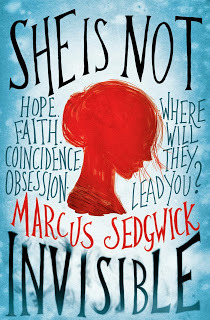
This is pertinent to She Is Not Invisible because the book consists of a first person narrative by a girl who has been blind from birth. The whole book, therefore, has to let the sense of sight go completely unused; but here’s the thing I found interesting: only when it was done did I realise that far from finding it limiting, I actually found it liberating. It was such a joy to be freed from the tyranny I think we often all feel; of ‘describing a scene fully’. With no sense of sight to have recourse to, I instead built scenes from the other senses, predominantly hearing, of course, but others too.
Here’s a short extract that shows this at work.
‘Benjamin!’ I called, waiting for him to come back.It was probably only a second or two but I freaked out and rushed after him, then kicked into a bag or something, and went sprawling full length on the floor.Even in the noise of the airport I heard everyone around me go quiet as they watched and I knew I’d made a stunning spectacle of myself. I’d landed with my legs over the bag and my arms flung out in front of me. ‘Am I invisible?’ a man said, angrily.My sunglasses had shot off my face somewhere and I heard him sigh.‘Why don’t you look where you’re going? My laptop’s in there.’I got to my feet and managed to kick his bag again.‘For God’s sake,’ he said.‘I’m sorry,’ I muttered. ‘Sorry.’I kept my head down as the man unzipped his bag, grumbling.‘Benjamin?’ I said, but he was already back at my side.‘Are you okay, Laureth?’ he asked, pushing something into my hands. ‘Here’s your glasses.’I slipped them on quickly.‘I’m really sorry,’ I said in the direction of the man, and held my hand out for Benjamin to take. ‘We’d better get a move on.’
No need for the sight of anything in there. Who cares what colour the man’s bag is, for example, or what make it is? The embarrassment of our narrator is the point in hand, and though I will of course return to the visual in my next book, it was a good experience to have.
In fact, in She Is Not Invisible, I decided to impose a few more restrictions on my writing. I’ve long been wanting to write a book that follows the maxims of Oulipo, or writing that is constrained in some way. Oulipo is a fascinating thing, and includes some extraordinary works, such George Perec’s famous A Void, written without once using the letter ‘e’. The proagonist’s father in She Is Not Invisible is a writer obsessed with two things; coincidences, and the number 354. I decided to see in how many ways I could incorporate this number into the text, from the chapter headers to the word count of the book even to the blurb on the jacket and the page count of the novel. And once again, far from finding this limiting, I actually found it stimulated me to be more creative than I might otherwise have been.
So try taking something out of your writing once in a while. You might indeed find that less is more.
LESS IS MORE
I’m a great believer in less-is-more. That should be apparent merely from the page extent of my books – they tend to the shorter side, in some cases, very deliberately so. Revolver, for example, is only about 33,000 words long. It’s my belief that many books, films, operas are simply too long, and that if you’re working well, you can actually achieve a more powerful overall effect by keeping your writing on the sparer side.
Of course, there’s an immediate risk that if you are going to keep things shorter, that you won’t sufficiently ‘build the world’, or ‘develop character’, or any one of the many others things you’re supposed to do when you write a book. But I think it’s just a question of choosing just the right things, just the right words, to do your work for you, and I would always rather err on the side of leaving a reader wanting more than overwhelming and boring them with a five page description of a new character the protagonist has just met, or three pages of detailed depiction of the room into which they have just walked.
In any case, I read somewhere that studies have shown that a reader only remembers three things from a lengthy description of a new room, for example, and if that’s the case, then why overload your passage with much more than that? The goal is to bring the scene to life, and I think there’s a false belief that some people have which means that as the writer, you have to describe everything. You don’t. One of the principal beauties of writing is that you can allow your reader to do half the work for you. If you choose just the right details to mention, and mention them in the most powerful or elegant way you can, you will immediately trigger a wealth of other images and suggestions in your readers’ minds.
I’ve got a new book out, called She Is Not Invisible, and it’s taught me something I found very interesting. I run creative writing courses from time to time, for Arvon and other places, and one of the short warm-ups I sometimes get the students to do involves describing a scene without the use of sight. I always feel a bit GCSE English at this point, but the results are often worthwhile – after the initial protests that it’s too limiting, the final pieces of writing are sometimes the best pieces of the week.

This is pertinent to She Is Not Invisible because the book consists of a first person narrative by a girl who has been blind from birth. The whole book, therefore, has to let the sense of sight go completely unused; but here’s the thing I found interesting: only when it was done did I realise that far from finding it limiting, I actually found it liberating. It was such a joy to be freed from the tyranny I think we often all feel; of ‘describing a scene fully’. With no sense of sight to have recourse to, I instead built scenes from the other senses, predominantly hearing, of course, but others too.
Here’s a short extract that shows this at work.
‘Benjamin!’ I called, waiting for him to come back.It was probably only a second or two but I freaked out and rushed after him, then kicked into a bag or something, and went sprawling full length on the floor.Even in the noise of the airport I heard everyone around me go quiet as they watched and I knew I’d made a stunning spectacle of myself. I’d landed with my legs over the bag and my arms flung out in front of me. ‘Am I invisible?’ a man said, angrily.My sunglasses had shot off my face somewhere and I heard him sigh.‘Why don’t you look where you’re going? My laptop’s in there.’I got to my feet and managed to kick his bag again.‘For God’s sake,’ he said.‘I’m sorry,’ I muttered. ‘Sorry.’I kept my head down as the man unzipped his bag, grumbling.‘Benjamin?’ I said, but he was already back at my side.‘Are you okay, Laureth?’ he asked, pushing something into my hands. ‘Here’s your glasses.’I slipped them on quickly.‘I’m really sorry,’ I said in the direction of the man, and held my hand out for Benjamin to take. ‘We’d better get a move on.’
No need for the sight of anything in there. Who cares what colour the man’s bag is, for example, or what make it is? The embarrassment of our narrator is the point in hand, and though I will of course return to the visual in my next book, it was a good experience to have.
In fact, in She Is Not Invisible, I decided to impose a few more restrictions on my writing. I’ve long been wanting to write a book that follows the maxims of Oulipo, or writing that is constrained in some way. Oulipo is a fascinating thing, and includes some extraordinary works, such George Perec’s famous A Void, written without once using the letter ‘e’. The proagonist’s father in She Is Not Invisible is a writer obsessed with two things; coincidences, and the number 354. I decided to see in how many ways I could incorporate this number into the text, from the chapter headers to the word count of the book even to the blurb on the jacket and the page count of the novel. And once again, far from finding this limiting, I actually found it stimulated me to be more creative than I might otherwise have been.
So try taking something out of your writing once in a while. You might indeed find that less is more.
Published on September 25, 2013 10:16
September 13, 2013
Western Isles Tour 5/5
The final day of this tour of the Western Isles took us to Barra, and the sun returned, having not been seen since Monday. Barra is a gorgeous little island and the people really friendly. I've been delighted to be able to come to the Western Isles thanks to the organisation of Scottish Book Trust and the generous sponsorship of Scottish Friendly, so I'd like to thank them both for making this happen.
I'm not going to write much today, but instead am going to post a load of photos from the day. As with every other day of the tour, we visited two schools; both primaries. The second was CastleBay School; and the first was the smallest school we've visited all week - Eoligarry, just 23 pupils in all - I spoke to just 8 of them. The school has been threatened with closure but has recently won a reprieve for three years. To the local people, the school is vital. It's doing a great job. And I very much hope it stays open, because we met some of the most wonderful young people I've ever met doing school visits. They're obviously doing something right here on Barra...
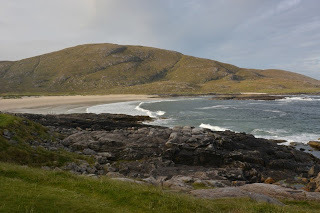 Our view at breakfast...
Our view at breakfast...
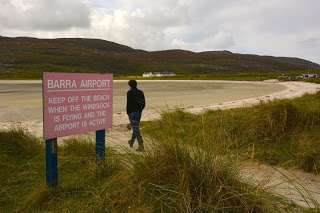
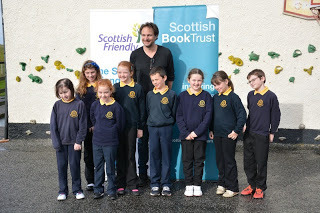 The whole of P4, P5, P6 and P7 at Eoligarry
The whole of P4, P5, P6 and P7 at Eoligarry
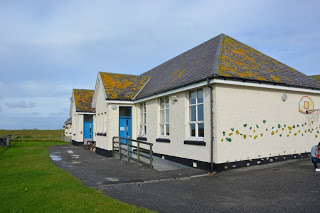 Eoligarry School, Barra
Eoligarry School, Barra
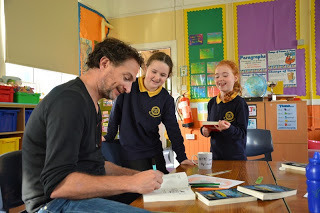
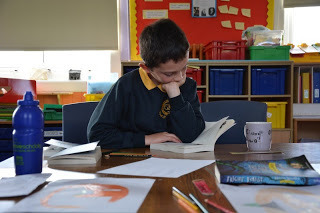
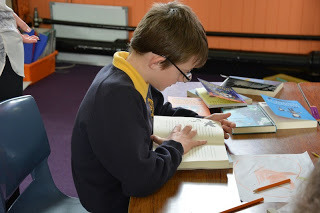
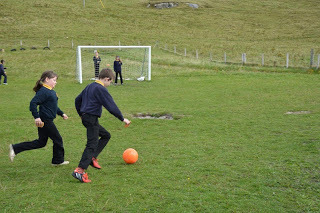 Football, including the hole in the centre of the pitch
Football, including the hole in the centre of the pitch
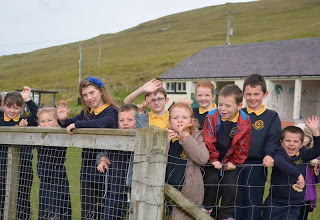 Saying goodbye...
Saying goodbye...
I'm not going to write much today, but instead am going to post a load of photos from the day. As with every other day of the tour, we visited two schools; both primaries. The second was CastleBay School; and the first was the smallest school we've visited all week - Eoligarry, just 23 pupils in all - I spoke to just 8 of them. The school has been threatened with closure but has recently won a reprieve for three years. To the local people, the school is vital. It's doing a great job. And I very much hope it stays open, because we met some of the most wonderful young people I've ever met doing school visits. They're obviously doing something right here on Barra...
 Our view at breakfast...
Our view at breakfast...
 The whole of P4, P5, P6 and P7 at Eoligarry
The whole of P4, P5, P6 and P7 at Eoligarry
 Eoligarry School, Barra
Eoligarry School, Barra


 Football, including the hole in the centre of the pitch
Football, including the hole in the centre of the pitch Saying goodbye...
Saying goodbye...
Published on September 13, 2013 07:54
September 12, 2013
Western Isles Tour 4/5
Day Four! The weather has really closed in on us now, but still there is no denying the beauty of these islands, even in the wet. And there is no denying also the friendliness of everyone we meet here – including complete strangers – last night a family passing by stopped to ask if we needed directions coming off the ferry, and invited us to follow them so we found the way to our hotel.
We headed down from North Uist to Lionacleit where I spoke to around 100 S1 and S2 students in their fantastic theatre space. Among them was the son of the family who’d helped us last night, who immediately asked if we’d got there okay. The session flew by and there wasn’t enough time to tackle everyone’s questions, sadly. Oh well, another time, I hope.
This afternoon we drove down to South Uist, passing some really pretty cottages, such as this thatched number whose roof appeared to be held down by rocks on a rope…

The venue for this afternoon’s event was Daliburgh School, where I spoke to around 50 P4-P7s. They were fantastic fun to talk with, five of whom helped me perform a short play with great enthusiasm, and then I answered as many questions as I could in ten minutes, ending with a good one. No children’s author can ever get too big for their boots, I think, because every now and again a young reader will ask something in all innocence which reminds you that, after all, you’re only some guy putting dumb ideas into a book, and nothing more than that.Example? ‘Last question then,’ I said, and picked a smiling boy in the back row. Then came the question that put me back in my box.‘Mr Sedgwick,’ he said. ‘Have you ever met any real authors..?’
Finally, here are some photos from today that really made me smile.
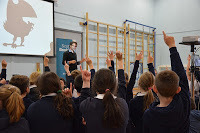
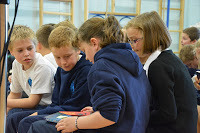
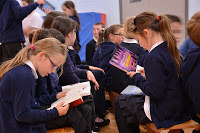
Published on September 12, 2013 10:32
September 11, 2013
Western Isles Tour 3/5
Day Three of the Scottish Friendly/Scottish Book Trust tour saw us well fed and rested after a lovely dinner last night, at which we met Kathleen Milne, head of library services for the Western Isles. We chatted about all sorts of things and it was interesting to hear about the role of mobile library services on the Isles; as important if not more so than the branches - the mobile library vans provide a vital source of culture for the islanders, offering an almost tailor-made service for the borrowers.
This morning, we said goodbye to Stornoway and made our first stop: Sgoil nan Loch in Leurbost. This proved to be an excellent primary school; I did an event with 45 children. They were absolutely delightful to spend time with, they had wonderful questions and five of them helped me out in a small theatrical performance at the end of the session. The four of us in Team Sedgwick/Scottish Book Trust are starting to get our heads around Gaelic spellings; and today threw us an excellent example: Ciorstaidh. Looks fiendish, turns out it's just the Gaelic way of spelling Kirsty. More linguistic challenges lie ahead though, I'm sure.
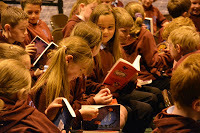
Over a pub lunch Team Sedgwick took on Team Scottish Book Trust at pool - I won't mention the result from modesty (ha, ha) but suffice to say that Beth and Michael clearly did not misspend their youth. The landlord offered to sell us his pub, we declined, not having over £300,000 in cash on us.
This afternoon, we visited a brand new school; the Sir E Scott School of West Tarbert. Here I spoke to around 60 pupils from S1, S2 and S3, and once again they proved to be a great bunch of young people. I chatted about various things from how much an author typically earns to some of the more obscure points of writing a book to why you can't just copy someone else's book and put your name on it. I had a great time with the young people there and was sad again to be leaving so soon.
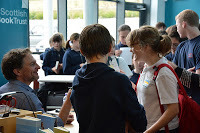
Now we're on North Uist; tomorrow beckons with two more primary schools, and no doubt a few more names that will twist the nib of my pen right off...
This morning, we said goodbye to Stornoway and made our first stop: Sgoil nan Loch in Leurbost. This proved to be an excellent primary school; I did an event with 45 children. They were absolutely delightful to spend time with, they had wonderful questions and five of them helped me out in a small theatrical performance at the end of the session. The four of us in Team Sedgwick/Scottish Book Trust are starting to get our heads around Gaelic spellings; and today threw us an excellent example: Ciorstaidh. Looks fiendish, turns out it's just the Gaelic way of spelling Kirsty. More linguistic challenges lie ahead though, I'm sure.

Over a pub lunch Team Sedgwick took on Team Scottish Book Trust at pool - I won't mention the result from modesty (ha, ha) but suffice to say that Beth and Michael clearly did not misspend their youth. The landlord offered to sell us his pub, we declined, not having over £300,000 in cash on us.
This afternoon, we visited a brand new school; the Sir E Scott School of West Tarbert. Here I spoke to around 60 pupils from S1, S2 and S3, and once again they proved to be a great bunch of young people. I chatted about various things from how much an author typically earns to some of the more obscure points of writing a book to why you can't just copy someone else's book and put your name on it. I had a great time with the young people there and was sad again to be leaving so soon.

Now we're on North Uist; tomorrow beckons with two more primary schools, and no doubt a few more names that will twist the nib of my pen right off...
Published on September 11, 2013 11:21
Western Isles tour 3/5
Day Three of the Scottish Friendly/Scottish Book Trust tour saw us well fed and rested after a lovely dinner last night, at which we met Kathleen Milne, head of library services for the Western Isles. We chatted about all sorts of things and it was interesting to hear about the role of mobile library services on the Isles; as important if not more so than the branches - the mobile library vans provide a vital source of culture for the islanders, offering an almost tailor-made service for the borrowers.
This morning, we said goodbye to Stornoway and made our first stop: Sgoil nan Loch in Leurbost. This proved to be an excellent primary school; I did an event with 45 children. They were absolutely delightful to spend time with, they had wonderful questions and five of them helped me out in a small theatrical performance at the end of the session. The four of us in Team Sedgwick/Scottish Book Trust are starting to get our heads around Gaelic spellings; and today threw us an excellent example: Ciorstaidh. Looks fiendish, turns out it's just the Gaelic way of spelling Kirsty. More linguistic challenges lie ahead though, I'm sure.

Over a pub lunch Team Sedgwick took on Team Scottish Book Trust at pool - I won't mention the result from modesty (ha, ha) but suffice to say that Beth and Michael clearly did not misspend their youth. The landlord offered to sell us his pub, we declined, not having over £300,000 in cash on us.
This afternoon, we visited a brand new school; the Sir E Scott School of West Tarbert. Here I spoke to around 60 pupils from S1, S2 and S3, and once again they proved to be a great bunch of young people. I chatted about various things from how much an author typically earns to some of the more obscure points of writing a book to why you can't just copy someone else's book and put your name on it. I had a great time with the young people there and was sad again to be leaving so soon.

Now we're on North Uist; tomorrow beckons with two more primary schools, and no doubt a few more names that will twist the nib of my pen right off...
This morning, we said goodbye to Stornoway and made our first stop: Sgoil nan Loch in Leurbost. This proved to be an excellent primary school; I did an event with 45 children. They were absolutely delightful to spend time with, they had wonderful questions and five of them helped me out in a small theatrical performance at the end of the session. The four of us in Team Sedgwick/Scottish Book Trust are starting to get our heads around Gaelic spellings; and today threw us an excellent example: Ciorstaidh. Looks fiendish, turns out it's just the Gaelic way of spelling Kirsty. More linguistic challenges lie ahead though, I'm sure.

Over a pub lunch Team Sedgwick took on Team Scottish Book Trust at pool - I won't mention the result from modesty (ha, ha) but suffice to say that Beth and Michael clearly did not misspend their youth. The landlord offered to sell us his pub, we declined, not having over £300,000 in cash on us.
This afternoon, we visited a brand new school; the Sir E Scott School of West Tarbert. Here I spoke to around 60 pupils from S1, S2 and S3, and once again they proved to be a great bunch of young people. I chatted about various things from how much an author typically earns to some of the more obscure points of writing a book to why you can't just copy someone else's book and put your name on it. I had a great time with the young people there and was sad again to be leaving so soon.

Now we're on North Uist; tomorrow beckons with two more primary schools, and no doubt a few more names that will twist the nib of my pen right off...
Published on September 11, 2013 11:21
September 10, 2013
Western Isles Tour 2/5
Day Two of this tour of the Western Isles of Scotland took us to our most northerly points – the villages of Back and Tolsta, where Team Scottish Booktrust/Sedgwick descended on their respective primary schools.
These were smaller events than yesterday in terms of the number of children at each school (though not as small as some of the ones to come later in the week). I spoke to around 70 children at Back and just 20 in Tolsta, but if the numbers were small, the friendly welcome was just as strong as the one we received in Stornoway yesterday. The children were from P3, P4 and P5 – I really love speaking with these age groups, the events can often veer off in directions you weren’t expecting as someone comes up with a totally original angle on a subject; for example, could you trap a ghost in the non-existent boxes that mime artists get stuck in? Ten minutes of discussion later, we got back on track, but I welcome such diversions – it shows that the imaginations of the young people are not to be underestimated.
Here’s a picture of the work that the P3 class at Tolsta had done on Fright Forest – some great pictures and even lovelier smiles:
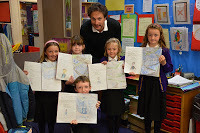
Between the two sessions today we had time to visit the ‘bridge to nowhere’, built by Lord Leverhulme when he owned the Isle of Lewis briefly between 1918 and 1923. His grand plans for the island ran aground and the road he intended to build beyond the bridge was never finished; this is the result:
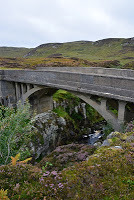
While horsing around on the nearby beach Lady Sedgwick deemed that my hair was behaving badly enough to recreate the poster for one of my favourite films:

What’s the film?
While I leave you with that puzzle, I’ll finish by saying that speaking with young people is endlessly enjoyable and also keeps you young yourself. And you can come across deep nuggets of insight too. Today, while signing a book for a young man who I’ll call Callum, I asked him how old he was. ‘Eight,’ he said. He paused, looking thoughtful. Then he added, ‘but I used to be seven.’
I’d drive a long way, anyday, for wisdom of that sort.
Published on September 10, 2013 08:48
September 9, 2013
Western Isles Tour 1/5
This is the first of five mini-blogs describing my week long tour of the Western Isles of Scotland. The tour has been organised by Scottish Book Trust and very generously sponsored by Scottish Friendly (more about them later in the week).
Lady Sedgwick and I arrived in Stornoway yesterday, flying up from Glasgow in a tiny little twin-prop, with a view from the window like this:

We met up with the team from Scottish Booktrust – the inimitable Beth Bottery and the redoubtable Mike Merillo, who drive something akin to the Mystery Machine. It remains to be seen whether we solve any spooky goings on in deserted gold mines while we’re here, but in the meantime, we’re going to talk books to the young people of the Hebrides.

Today I felt like I saw both ends of the writing process: we visited two schools in Stornoway itself: the Isle of Lewis’s largest primary school in the morning, and the largest secondary school in the afternoon. We got a very warm welcome in both schools – here’s a shot of the signing queue at the Nicholson Institute:
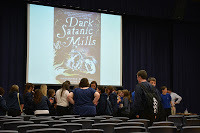
After the events, we had a flying visit to see the standing stones at Callanish. Anyone who knows me knows that I love a fine piece of neolithic action, so it was fantastic to see the stones. And if talking to young readers is the very end of the writing process, a trip like this is, for me, the kind of thing that can prove to be the very beginning of a book. A book like The Dark Horse, for example, is based in this kind of landscape, and who knows yet whether my week on the Western Isles will lead to anything creative. Seeing all the windfarms here also got me thinking about Julia Green’s great book, This Northern Sky, set amongst just such a landscape.

Questions of my creativity aside, at the very least we saw a stunning example of someone else's. We were taking a bite in a café by the standing stones, and I was just expounding the idea to Mike that you learn something knew every day, when around the corner came a cat, straining on a leash. Strange enough, but we expected to see a person on the other end. When it turned out to be another cat on the other end, clearly straining in the other direction as hard as possible, we realised that here is the solution to the well-known expression of disorder: “herding cats”. The answer is simple – tie the damn things together.
Happy with this new-found knowledge, we headed back to Stornoway, where the only remaining problem is how you get round the fluffy roadblocks every couple of miles.
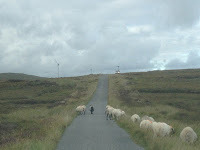
Published on September 09, 2013 11:08
Marcus Sedgwick's Blog
- Marcus Sedgwick's profile
- 1579 followers
Marcus Sedgwick isn't a Goodreads Author
(yet),
but they
do have a blog,
so here are some recent posts imported from
their feed.



